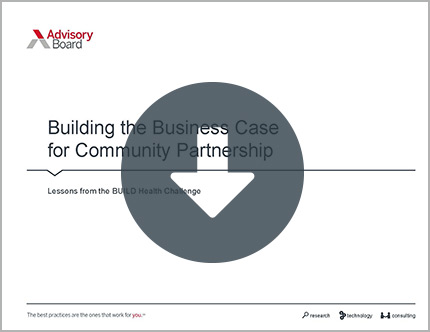Auto logout in seconds.
Continue LogoutRead Advisory Board's take: How to improve diversity and inclusion at your organization
Forbes recently released its second annual list of the "Best Employers for Diversity"—and 29 hospitals and health systems made the list.
Q&A: How to build a diverse leadership bench
Methodology
For the list, Forbes and research firm Statista surveyed 50,000 employees in the United States, posing questions about age, disability, diversity, ethnicity, and sexual orientation. Companies eligible for consideration had to have at least 1,000 employees.
This year, the list included 500 employers, twice the number included in last year's list.
Hospitals, health systems on the list
The 29 hospitals and health systems recognized on the list, in order of ranking, are:
- Mount Sinai Health Systems* (New York);
- University of Iowa Hospitals & Clinics* (Iowa City, Iowa);
- UCLA Health* (Los Angeles);
- Novant Health* (Charlotte, North Carolina);
- Mayo Clinic* (Rochester, Minnesota);
- Cincinnati Children's* (Cincinnati);
- Bellin Health* (Green Bay, Wisconsin);
- Roswell Park Comprehensive Cancer Center* (Buffalo, New York);
- University of Utah Health Care* (Salt Lake City);
- UCSF Medical Center* (San Francisco);
- Penn Medicine* (Philadelphia);
- St. Jude Children's Research Hospital* (Memphis, Tennessee);
- Kaiser Permanente* (Oakland, California);
- Emory Healthcare* (Atlanta);
- Loyola University Medical Center* (Maywood, Illinois);
- Cleveland Clinic* (Cleveland);
- Penn State Health* (Hershey, Pennsylvania);
- UC Davis Health System* (Sacramento, California);
- Boston Children's Hospital (Boston);
- Texas Health Resources* (Arlington, Texas);
- Dana-Farber Cancer Institute* (Boston);
- Columbus Regional Health* (Columbus, Indiana);
- MD Anderson Cancer Center* (Houston);
- Methodist Le Bonheur Healthcare* (Memphis, Tennessee);
- Johns Hopkins Medicine* (Baltimore);
- Sharp HealthCare* (San Diego);
- Lee Memorial Health System* (Fort Myers, Florida);
- Providence St. Joseph Health* (Renton, Washington); and
- BayCare* (Clearwater, Florida).
*Denotes Advisory Board member
Other health care honorees
The list also featured 70 non-hospital or health system employers that work in the health care industry, including 26 that are Advisory Board members:
- Johnson & Johnson (New Brunswick, New Jersey);
- McKesson (San Francisco);
- AbbVie (Chicago);
- Boston Scientific (Marlborough, Massachusetts);
- Stryker (Kalamazoo, Michigan);
- Pfizer (New York);
- Blue Cross & Blue Shield of Massachusetts (Boston);
- AstraZeneca (Wilmington, Delaware);
- Medtronic (Minneapolis);
- Novartis (Hanover, New Jersey);
- Blue Cross & Blue Shield of North Carolina (Durham, North Carolina);
- Cigna (Bloomfield, Connecticut);
- Biogen (Cambridge, Massachusetts);
- Baxter International (Deerfield, Illinois);
- Cook Medical (Bloomington, Indiana);
- Cardinal Health (Dublin, Ohio);
- Bayer (Whippany, New Jersey);
- Abbott Laboratories (Abbot Park, Illinois);
- Becton Dickinson (Franklin Lakes, New Jersey);
- Smith & Nephew (Memphis, Tennessee);
- Roche Holding (San Francisco);
- Lilly (Indianapolis);
- Bristol-Myers Squibb (New York);
- Aetna (Hartford, Connecticut);
- Cerner (Kansas City, Missouri); and
- Medline Industries (Northfield, Illinois) ("Best Employers for Diversity," Forbes, 1/15; Valet, Forbes, 1/15).
Advisory Board's take

Micha'le Simmons, Senior Consultant, HR Advancement Center
We find that organizations who are most advanced in their diversity and inclusion strategy aren't just investing in additional programs, or doing it out of compliance, but pushing for substantive changes to their talent policies and practices.
For instance, we've seen several progressive organizations increase their diversity by:
- Moving towards an evidence-based selection screening process. In the hiring process, interviewers can inadvertently discount otherwise strong candidates due to unconscious biases. By standardizing the hiring process for pre-selected skills and competencies, HR leaders can fight these unconscious patterns.
For instance, when Mercy Health West Michigan, a multi-campus health care system, redesigned their hiring process around objective tests for specific skills and standardized their interview questions to assess pre-determined competencies, they were able to increase the percentage of non-white hires by more than 11%. They also reduced time-to-fill for their roles by six days and first-year turnover by 6.6%.
Learn more about this program here.
- Removing barriers that overlook under-tapped candidate pools. Nearly every labor market contains pools of talent that organizations are overlooking either accidentally or because they contain an attribute the organization has decided disqualifies candidates.
“Nearly every labor market contains pools of talent that organizations are overlooking”
Johns Hopkins Hospital has committed to a multi-pronged approach to increase their workforce diversity. In 2015, they launched HopkinsLocal, an initiative committed to hiring in 16 economically-depressed zip codes with the goal to fill 40% of targeted entry-level roles from these areas by 2018. They work with local faith-based organizations and other community partnerships to recruit these candidates. They've also made hiring ex-criminal offenders—a population often overlooked in the workforce—an intentional part of their workforce strategy, hiring an ex-police officer to assess candidates past convictions and make recommendations about their suitability as employees.
Learn more about this program here.
- Creating a pipeline to leadership. Many organizations invest in leadership development and high-potential leadership programs, but without a conscious focus on diversity, these programs can fail to actually increase diversity in senior leadership.
Baptist Health South Florida chose to intentionally build diversity into its existing high-potential leadership program. Each yearly leadership development program has six cohorts made up of individuals across the organization who come up with an action plan to tackle a project sponsored by a senior leader and present their findings to a senior group. They check to make sure that diverse pools of talent are represented in these cohorts, and, if they're not, encourage leaders to check each other for unconscious bias in talent reviews.
Learn more about their approach to diversity in a Q&A with their Chief Diversity Officer here.
These are just a few of the ways that organizations can increase diversity. Other solutions might include putting more rigor around performance evaluation criteria—adding in objective performance goals, or clearly defining qualitative criteria—in order to reduce some inherent bias when evaluating performance. Some organizations might decide that when they have a vacant leadership slot, they will not move forward with hiring until they have a diverse slate of candidates to evaluate. These changes in talent policies and practices can change the commitment to diversity and inclusion from being on the surface to achieving lasting change in the organization.
We're currently conducting new research on how HR leaders can support greater diversity at their organizations and we'd love to hear from you: What are the questions you have about developing or executing your diversity and inclusion strategy? Email me your questions hereNext: Get 1-page cheat sheets on how "Best Places to Work" organizations are chosen
Is your organization recognized as a "best place to work?" If not, you could be missing an important tool to recruit new employees—and a big opportunity to spotlight your employee engagement work with current staff. Download our cheat sheets to learn exactly how influential publications decide who makes the cut (and who doesn't):
Don't miss out on the latest Advisory Board insights
Create your free account to access 1 resource, including the latest research and webinars.
Want access without creating an account?
You have 1 free members-only resource remaining this month.
1 free members-only resources remaining
1 free members-only resources remaining
You've reached your limit of free insights
Become a member to access all of Advisory Board's resources, events, and experts
Never miss out on the latest innovative health care content tailored to you.
Benefits include:
You've reached your limit of free insights
Become a member to access all of Advisory Board's resources, events, and experts
Never miss out on the latest innovative health care content tailored to you.
Benefits include:
This content is available through your Curated Research partnership with Advisory Board. Click on ‘view this resource’ to read the full piece
Email ask@advisory.com to learn more
Click on ‘Become a Member’ to learn about the benefits of a Full-Access partnership with Advisory Board
Never miss out on the latest innovative health care content tailored to you.
Benefits Include:
This is for members only. Learn more.
Click on ‘Become a Member’ to learn about the benefits of a Full-Access partnership with Advisory Board
Never miss out on the latest innovative health care content tailored to you.

